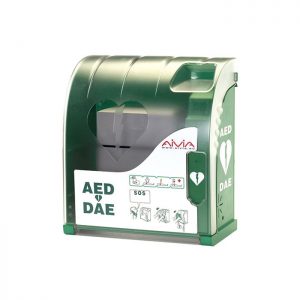What does a defibrillator do?
Defibrillators give a high energy electric shock to the heart of someone who has suffered a cardiac arrest to restore the heart’s normal rhythm.
Defibrillation along with CPR, gives cardiac arrest patients the best possible chance of survival.
The devices are easy to use, provide audible &/or visual instructions to the user and will not deliver a shock unless it is required. No training is required to use the equipment.
Why do defibrillators need a cabinet?



Not all defibrillators are stored in a cabinet. Some premises may store them behind reception on a shelf, or in an office. These defibrillators tend to only be available when the premises is open. We would strongly advise all organisations who have a defibrillator to ensure it is visible so that it is easily accessed in an emergency.
Defibrillators which are available 24/7 are often stored in yellow or green metal or plastic cabinets in public spaces to keep them safe and dry.
If someone has suffered a cardiac arrest and you need a defibrillator, staff in our Emergency Operations Centre can direct 999 callers to their nearest ‘emergency ready’ device (within 1 mile of an incident) and provide a code to the secure cabinet it’s contained in if necessary, you MUST ensure you provide the access code when registering your device.
To find out more about defibrillator cabinets, where to place them, what to consider when purchasing one and how to maintain it please read our Guide to Defib cabinets.
Defibrillator locations may be highlighted by the use of these signs:


You can download these posters from the Resuscitation Council UK here: Guidance: Standard sign for AEDs | Resuscitation Council UK
Where is my closest defibrillator?
There are more than 2500 defibrillators registered with NI Ambulance Service on the Circuit. Having a defibrillator in your workplace or local community can help save lives, but it must be registered so that our staff in the Emergency Operations Centre can instruct a bystander to go and retrieve it.
If you want to know where your closest defibrillator is located and if it is emergency ready or not then please visit www.defibfinder.uk this is a national map of all registered defibs.
Buying a defibrillator
If you are considering purchasing a defibrillator for your community, please visit www.defibfinder.uk in the first instance, to see the location of all the defibrillators in your local area. If you need further advice then please contact the NIAS Community Resusitation Team at resus.admin@nias.hscni.net or phone 028 9040 5215.
Don’t forget to register your defibrillator
If you have a defibrillator in your workplace, school or local community, don’t forget to register it with NI Ambulance Service on The Circuit so that we know it’s available to help save lives. It’s quick and easy to do – you’ll just need a few key details to hand such as information about the location of where the defibrillator is permanently kept and information about the defibrillator itself.
For a step by step guide to registering your permanently located defibrillator please follow the document – Guide to registering your defibrillator. You should only register your defibrillator if is in a permanent location, and available 24/7 or has regular accessible hours.
If you have a defibrillator which is mobile in the boot of your car or does not have regular accessible hours then please do not register it as we need to know when it is available and where it is located so we can send a bystander to retrieve it if needed.

To set up your account on The Circuit, and to register your defibrillator with us, please click here.
To complete your registration, please make sure you have the following information about your defibrillator to hand:

- The full address and location of the where the defibrillator is permanently located(including any extra details such as ‘on the third floor by the photocopier’)
- The brand and model (usually to be found on the front) and serial number (usually on the underside, you may need to remove the battery in some brands)
- Accessibility days and times
- Pads expiry date
- Confirmation that your defibrillator is displaying the ‘emergency ready’ signal when you last checked it (usually a flashing green light or a green tick, depends on the brand)
- Access code (if the defibrillator is kept in a locked cabinet)
Don’t forget to purchase a ‘rescue ready kit’ which is vital when applying the defibrillator pads.
For further information about defibrillators please read the following documents:





